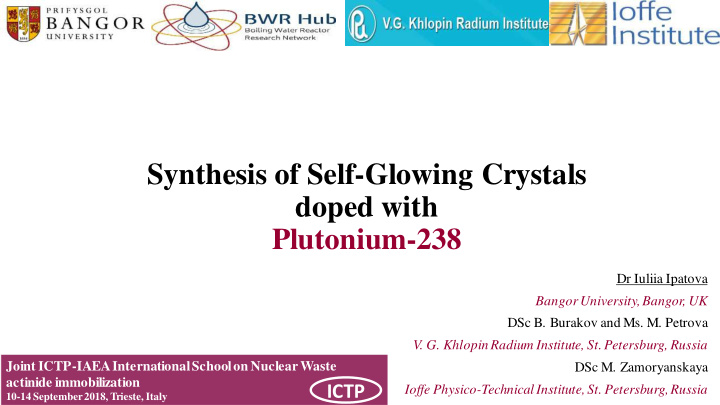



Synthesis of Self-Glowing Crystals doped with Plutonium-238 Dr Iuliia Ipatova Bangor University, Bangor, UK DSc B. Burakov and Ms. M. Petrova V. G. Khlopin Radium Institute, St. Petersburg, Russia Joint ICTP-IAEA International School on Nuclear Waste DSc M. Zamoryanskaya actinide immobilization ICTP Ioffe Physico-Technical Institute, St. Petersburg, Russia 10-14 September 2018, Trieste, Italy
Actinide immobilization includes not only: development and use of durable advanced materials (ceramic/glass waste forms) before final geological disposal but also – advanced materials such as: • inert ceramic nuclear fuel • durable sources of alpha-irradiation • self-glowing crystals 2
In general, radioactive glowing sources developed in the past consist of several separate parts: 1) Non-radioactive crystalline material doped with non-radioactive luminescence ion (for example, ZnS doped with Eu 3+ ) Highly radioactive material (for example, 238 PuO 2 ) 2) 3) Hermetically sealed body(made of steel and transparent glass) 3
Combination of all three parts in one durable crystal matrix Less than 0.1 wt.% for 238 Pu too high or too small content of luminescence ion(s) will cause weak self-glowing optimal ratio between luminescence ion(s) and alpha-emitter(s) 4
Durable and intensively self-glowing crystals are advanced materials for use in extreme environment for: • optical couplers • robotics • medicine • other fields 5
Intensive long-term radio-luminescence might be converted into electric current that allows development of reliable “ nuclear ” batteries . Such nuclear batteries can potentially be used in aggressive chemical media as well as for applications in space for dozens to hundreds of years. 6
Why zircon? • Chemically inert (even at high temp. ~1600 ° C) • Resistant to natural self-irradiation or heavy ion irradiation • Mechanically and geochemically stable which allows to use it for determining isotopic dating of rocks* • Considered as universal matrix for: ✓ reliable matrix for the final actinide immobilization ✓ safest sources of ionizing radiation and radio-luminescent component of "nuclear" batteries ✓ creating innovative materials 7 *A.C. McLaren et al. 1994
Main aims • To synthesize self-glowing crystals of zircon with impurities: ✓ Terbium (Tb 3+ ) and Europium (Eu 3+ ) as luminescence ions Tb 3+ is well known luminescence ion but ( Tb 3+ + Eu 3+ ) in a couple may provide much more intensive luminescence ✓ Plutonium-238 as a glowing activator • To achieve intense strong glowing of the developed zircon crystals • Keep safe working with highly active open sources 8
Main difficulties • To find the optimal ratio between luminescence ions and actinide • Terbium can be in two valence states: (3+) and (4+) and europium: (3+) and (2+). However, only terbium (3+) and europium (3+) are known as effective luminophores => To find the way to stabilize trivalent state • The content of the radionuclide should be minimal (no more than 0.1 wt. % for plutonium-238) 9
Synthesis of crystals by flux method 1 up to 48 hours MoO 3 (flux)+SiO 2 +ZrO 2 +PuO 2 +Tb 2 O 3 /Eu2O 3 (Zr-phosphate) or TbPO 4 /EuPO 4 10
Synthesis of crystals by flux method 2 Furnace (max.T=1300 ° C) Washing crystals in Grown zircon crystals 25% aqueous solution of NH 4 OH at the bottom of Pt crucible and HNO 3 Pt crucible containing starting precursor 11
Chemical properties. Valence state. It is very difficult to incorporate essential amount of Tb 3+ into zircon crystal structure substituting Zr 4+ Also, Tb incorporated into zircon can be in two valence states: (3+) and (4+) but only trivalent Tb 3+ are luminescence ions Admixture of phosphor* may support incorporation of trivalent lanthanides into zircon structure due to charge compensation: (Zr,Tb)(Si,P)O 4 Zr 4+ + Si 4+ = Tb 3+ + P 5+ 12 * J.M. Hancharet al. 2001
The best luminescence ions as well as their optimal contents are different for different crystalline host phase The use of cathodoluminescence spectroscopy may help in identifying optimal content of luminescence ion 13
Cathodoluminescence image of valence- zoned non-radioactive zircon crystal doped with Tb (diameter of electron beam 100 µm) Zircon crystal Acrylic resin 14
CL-spectra of non-radioactive zircon crystals doped with Tb + monoclinic zirconia as a minor phase 15
Zircon crystals : a, c – in normal light; b, d – in the ultraviolet Intense luminescence! a b (Zr, Tb )(Si, P)O 4 1 mm c d (Zr, Eu )(Si, P)O 4 16
Principal features of zircon crystals observed 17
Self-glowing crystals of zircon, (Zr,Pu,Tb)(Si,P)O 4 doped with: 0.02 wt.% 238 Pu 0.2-0.3 wt.% Tb 0.2-0.3 wt.% P 18
Self-glowing crystals of zircon, (Zr,Pu,Eu)(Si,P)O 4 doped with: 0.01 wt.% 238 Pu 0.3 wt.% Eu 0.2 wt.% P 19
Zircon crystals 20
Conclusions • Intensively self-glowing crystals of zircon (Zr,Tb,Eu,Pu)SiO 4 were successfully obtained. Contents of 238 Pu in these crystals did not exceed 0.02 wt.% • Maximum luminescence intensity is observed at a concentration of Eu in a range 0.1-0.2 wt.% and Tb – 4wt.% • CL-spectroscopy is an efficient tool that allows identifying optimal content of luminescence ion in non-radioactive crystals. The same content of luminescence ion should be incorporated into radioactive crystals in order to provide highest intensity of self-glowing • Study of optimal balance between actinide content and amount of non-radioactive luminescence ion(s) should allow obtaining relatively low radioactive crystals with intensive radioluminescence 21
22
Recommend
More recommend